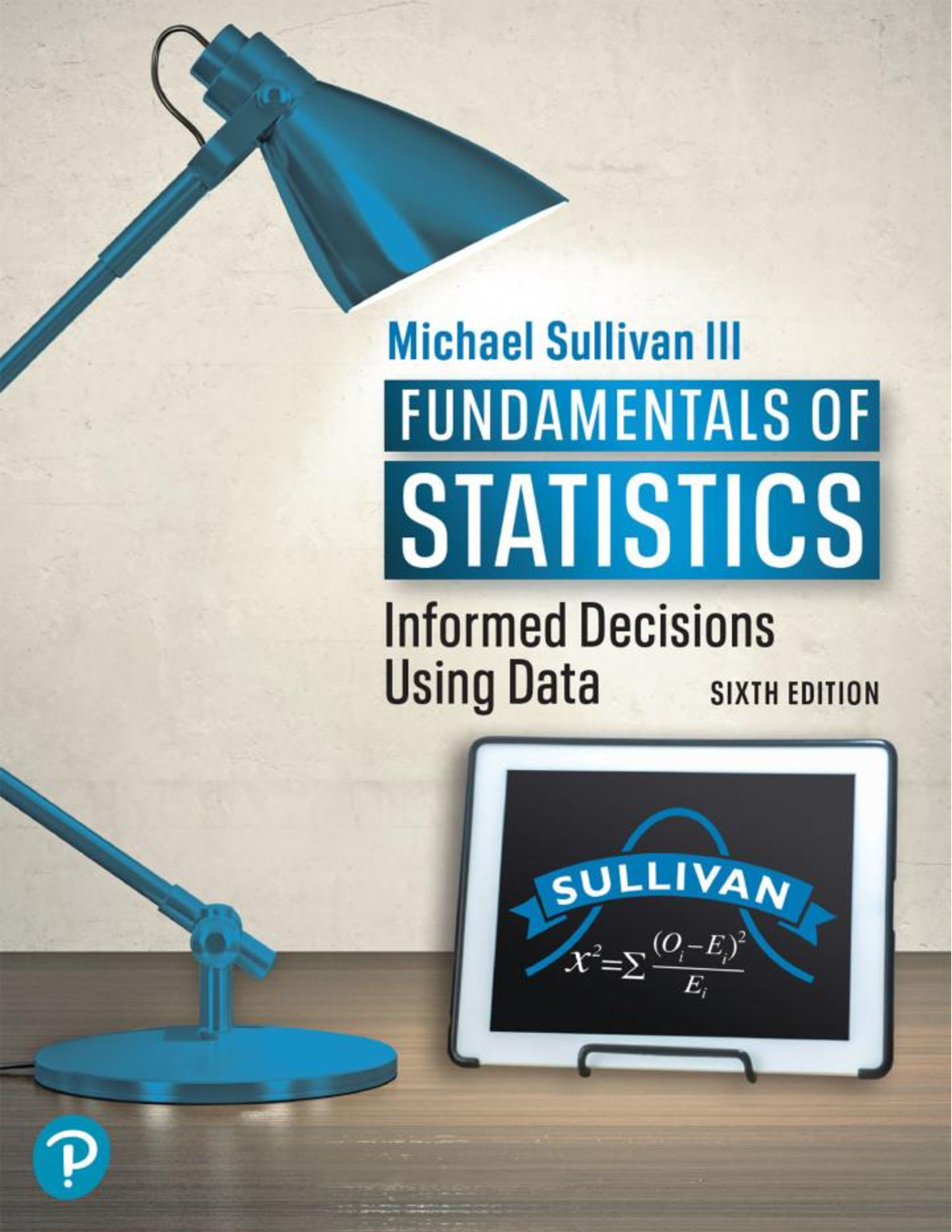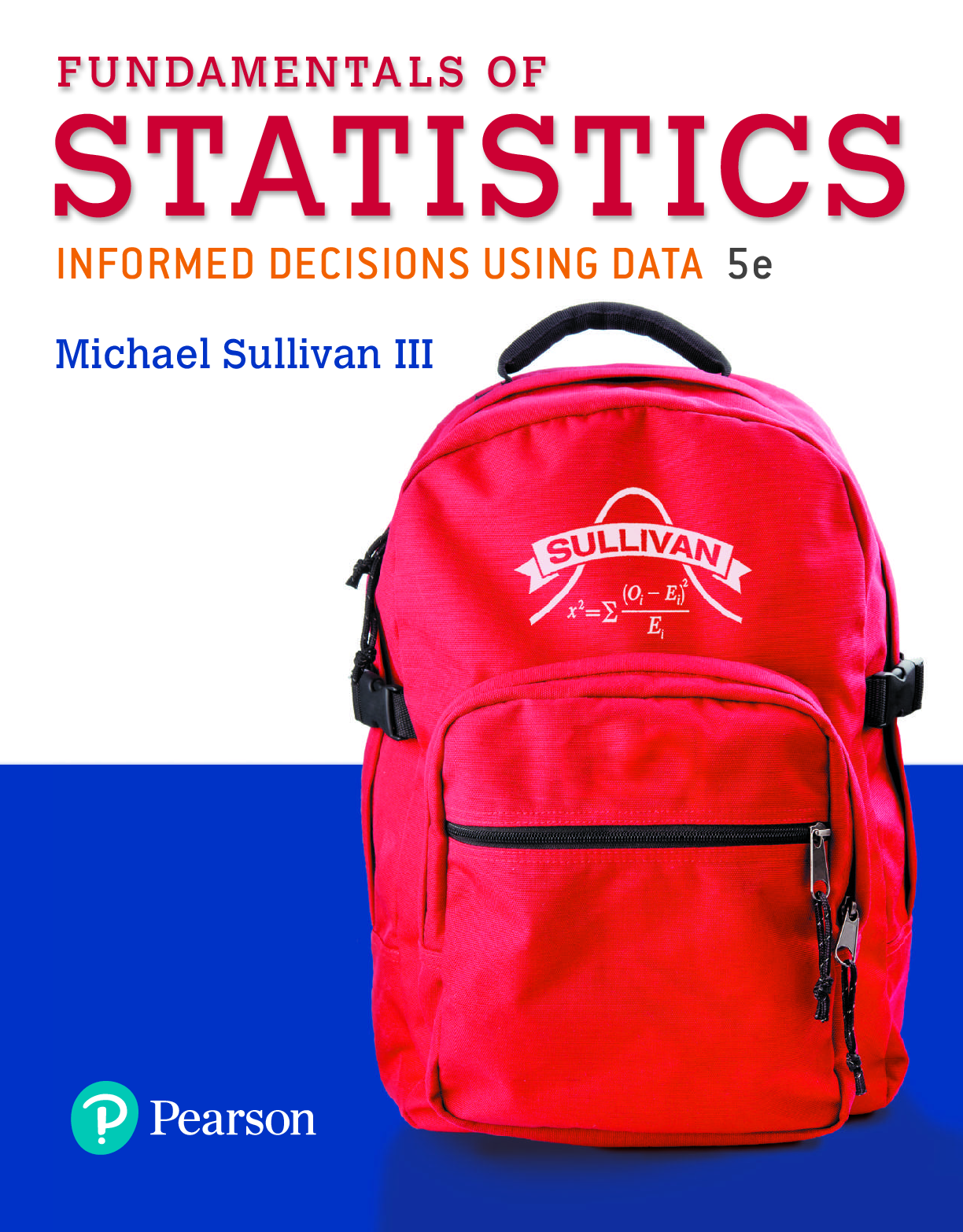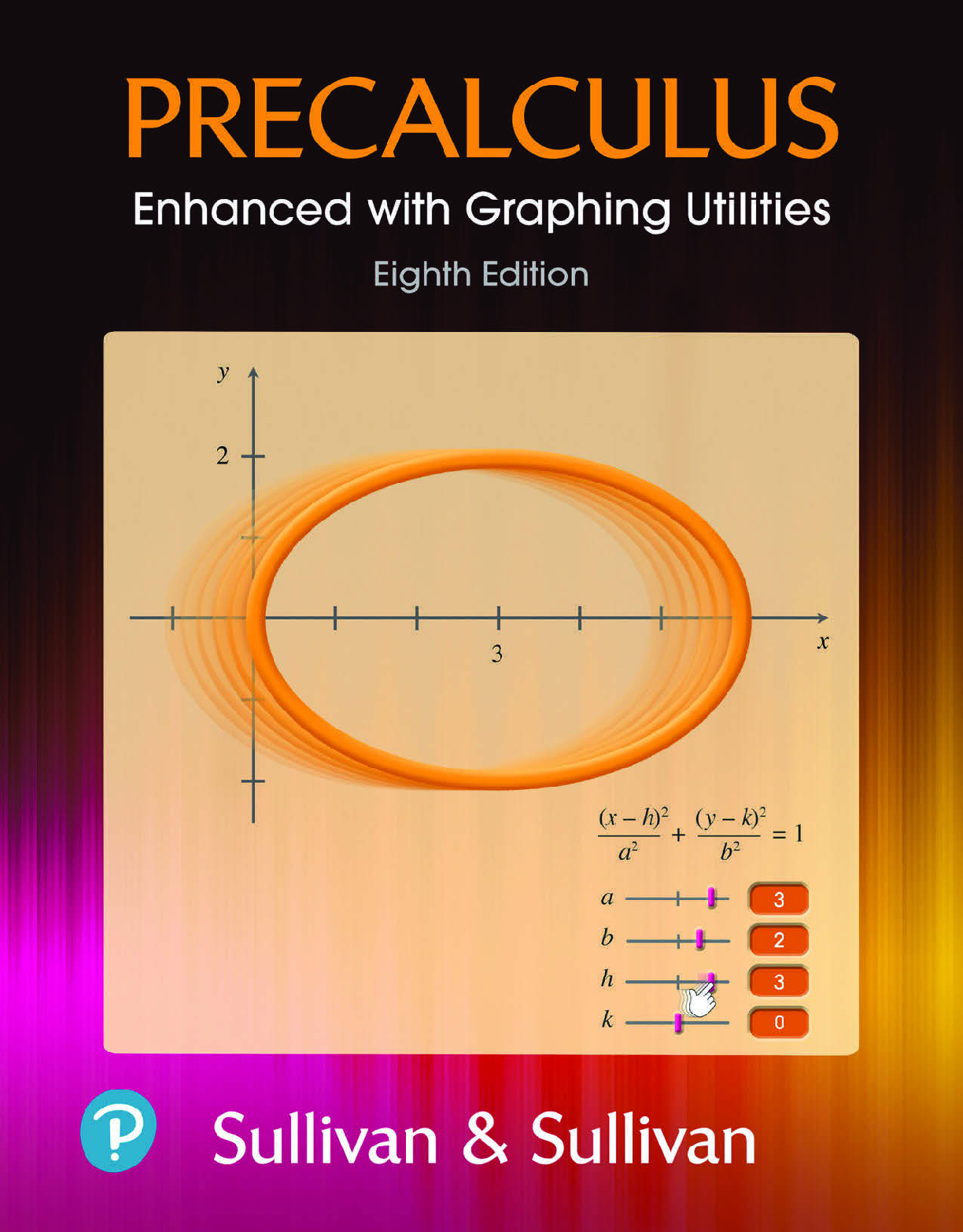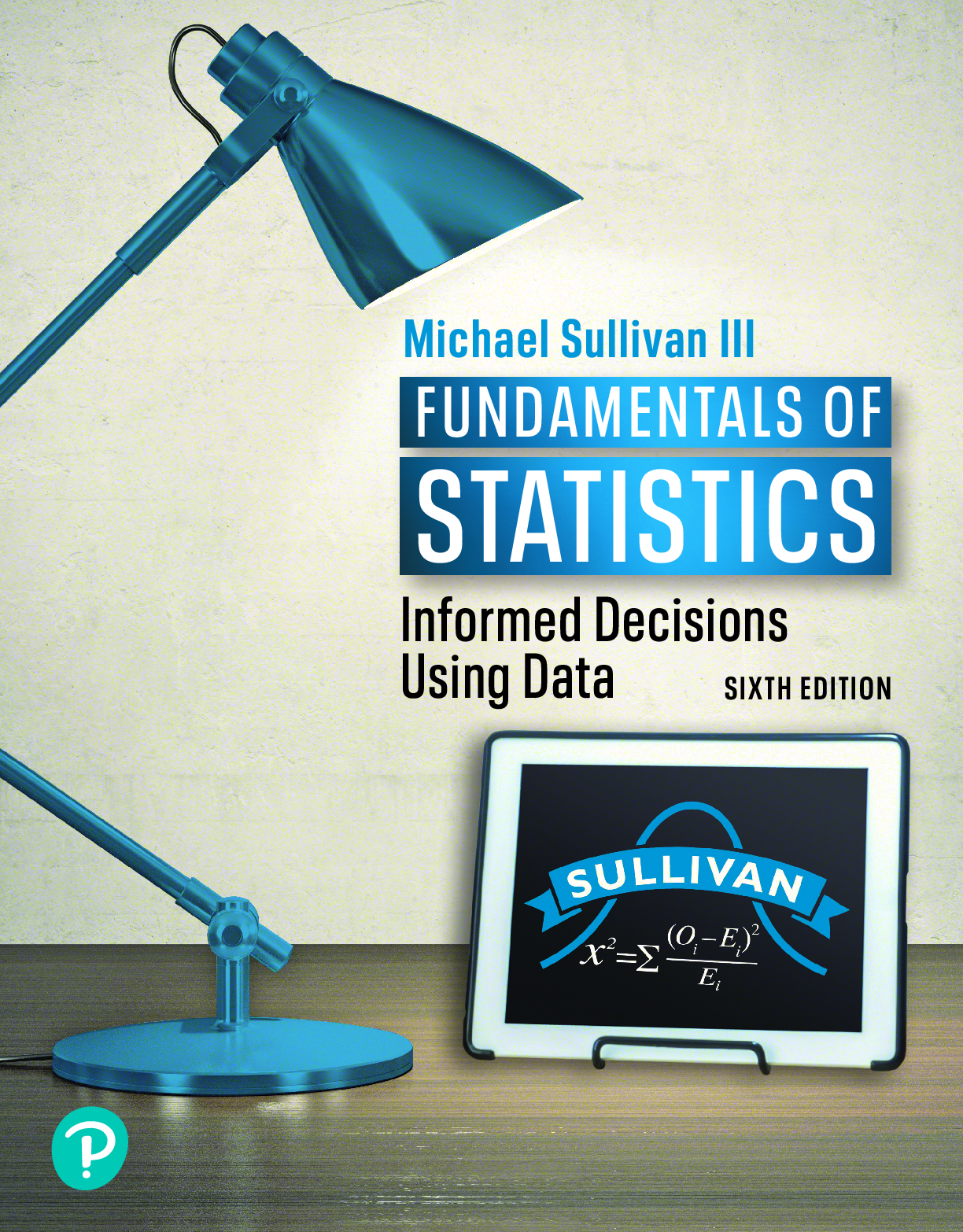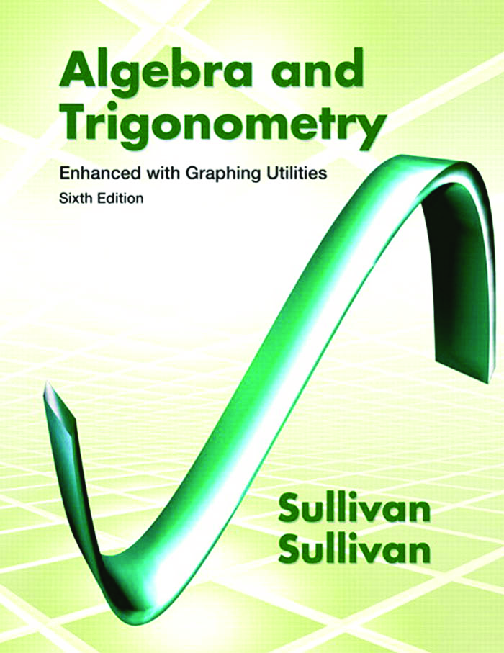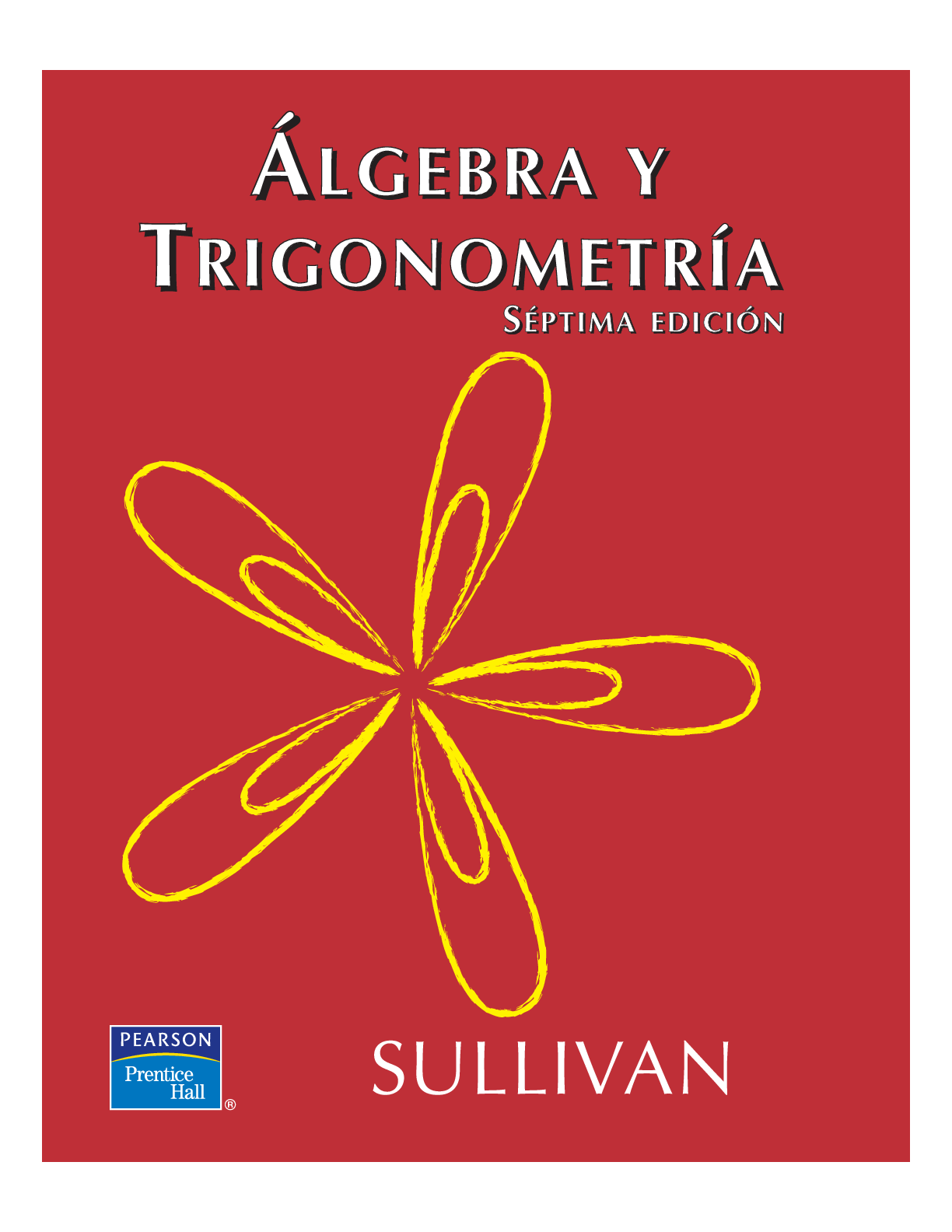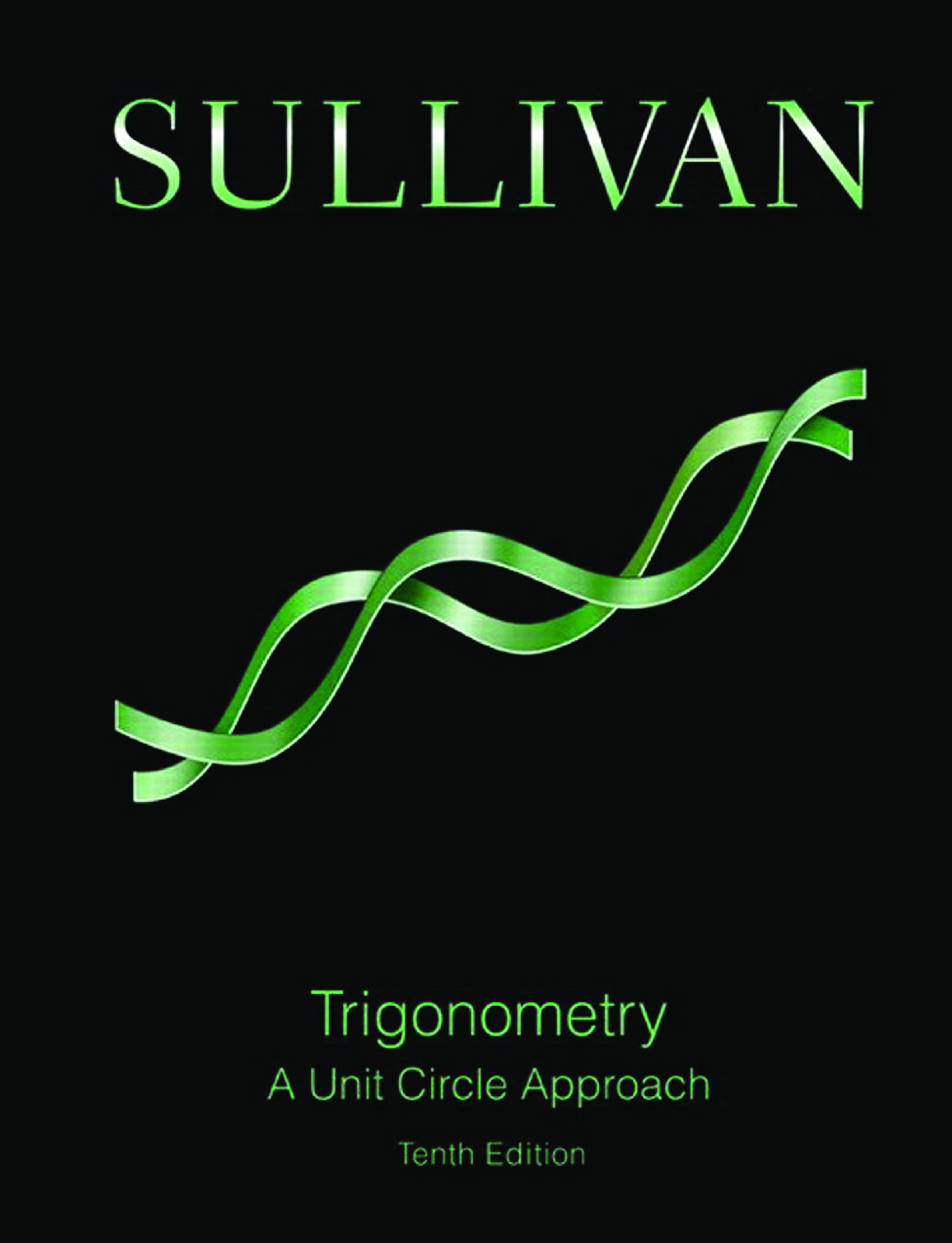eBook [PDF] Precalculus, 11th Edition By Michael Sullivan
Document Content and Description Below
eBook [PDF] Precalculus, 11th Edition By Michael Sullivan Inside Front Cover To the Student Prepare for Class “Read the Book” Practice “Work the Problems” Review “Study for Quizzes an... d Tests” Dedication Title Page Copyright Page Contents Three Distinct Series The Flagship Series Preface to the Instructor Get the Most Out of MyLab Math Resources for Success Applications Index 1 Graphs 1.1 The Distance and Midpoint Formulas 1 Use the Distance Formula 2 Use the Midpoint Formula 1.2 Graphs of Equations in Two Variables; Intercepts; Symmetry 1 Graph Equations by Plotting Points 2 Find Intercepts from a Graph 3 Find Intercepts from an Equation 4 Test an Equation for Symmetry with Respect to the x-Axis, the y-Axis, and the Origin Know How to Graph Key Equations 1.3 Lines 1 Calculate and Interpret the Slope of a Line 2 Graph Lines Given a Point and the Slope 3 Find the Equation of a Vertical Line 4 Use the Point-Slope Form of a Line; Identify Horizontal Lines 5 Use the Slope-Intercept Form of a Line 6 Find the Equation of a Line Given Two Points 7 Graph Lines Written in General Form Using Intercepts 8 Find Equations of Parallel Lines 9 Find Equations of Perpendicular Lines 1.4 Circles 1 Write the Standard Form of the Equation of a Circle 2 Graph a Circle 3 Work with the General Form of the Equation of a Circle Chapter Review Chapter Test Chapter Project 2 Functions and Their Graphs 2.1 Functions 1 Describe a Relation 2 Determine Whether a Relation Represents a Function 3 Use Function Notation; Find the Value of a Function 4 Find the Difference Quotient of a Function 5 Find the Domain of a Function Defined by an Equation 6 Form the Sum, Difference, Product, and Quotient of Two Functions 2.2 The Graph of a Function 1 Identify the Graph of a Function 2 Obtain Information from or about the Graph of a Function 2.3 Properties of Functions 1 Identify Even and Odd Functions from a Graph 2 Identify Even and Odd Functions from an Equation 3 Use a Graph to Determine Where a Function is Increasing, Decreasing, or Constant 4 Use a Graph to Locate Local Maxima and Local Minima 5 Use a Graph to Locate the Absolute Maximum and the Absolute Minimum 6 Use a Graphing Utility to Approximate Local Maxima and Local Minima and to Determine Where a Funct 7 Find the Average Rate of Change of a Function 2.4 Library of Functions; Piecewise-defined Functions 1 Graph the Functions Listed in the Library of Functions 2 Analyze a Piecewise-defined Function 2.5 Graphing Techniques: Transformations 1 Graph Functions Using Vertical and Horizontal Shifts 2 Graph Functions Using Compressions and Stretches 3 Graph Functions Using Reflections about the x-Axis and the y-Axis 2.6 Mathematical Models: Building Functions 1 Build and Analyze Functions Chapter Review Chapter Test Cumulative Review Chapter Projects 3 Linear and Quadratic Functions 3.1 Properties of Linear Functions and Linear Models 1 Graph Linear Functions 2 Use Average Rate of Change to Identify Linear Functions 3 Determine Whether a Linear Function Is Increasing, Decreasing, or Constant 4 Build Linear Models from Verbal Descriptions 3.2 Building Linear Models from Data 1 Draw and Interpret Scatter Plots 2 Distinguish between Linear and Nonlinear Relations 3 Use a Graphing Utility to Find the Line of Best Fit 3.3 Quadratic Functions and Their Properties 1 Graph a Quadratic Function Using Transformations 2 Identify the Vertex and Axis of Symmetry of a Parabola 3 Graph a Quadratic Function Using Its Vertex, Axis, and Intercepts 4 Find a Quadratic Function Given Its Vertex and One Other Point 5 Find the Maximum or Minimum Value of a Quadratic Function 3.4 Building Quadratic Models from Verbal Descriptions and from Data 1 Build Quadratic Models from Verbal Descriptions 2 Build Quadratic Models from Data 3.5 Inequalities Involving Quadratic Functions 1 Solve Inequalities Involving a Quadratic Function Chapter Review Chapter Test Cumulative Review Chapter Projects 4 Polynomial and Rational Functions 4.1 Polynomial Functions 1 Identify Polynomial Functions and Their Degree 2 Graph Polynomial Functions Using Transformations 3 Identify the Real Zeros of a Polynomial Function and Their Multiplicity 4.2 Graphing Polynomial Functions; Models 1 Graph a Polynomial Function 2 Graph a Polynomial Function Using a Graphing Utility 3 Build Cubic Models from Data 4.3 Properties of Rational Functions 1 Find the Domain of a Rational Function 2 Find the Vertical Asymptotes of a Rational Function 3 Find a Horizontal or an Oblique Asymptote of a Rational Function 4.4 The Graph of a Rational Function 1 Graph a Rational Function 2 Solve Applied Problems Involving Rational Functions 4.5 Polynomial and Rational Inequalities 1 Solve Polynomial Inequalities 2 Solve Rational Inequalities 4.6 The Real Zeros of a Polynomial Function 1 Use the Remainder and Factor Theorems 2 Use Descartes’ Rule of Signs to Determine the Number of Positive and the Number of Negative Real 3 Use the Rational Zeros Theorem to List the Potential Rational Zeros of a Polynomial Function 4 Find the Real Zeros of a Polynomial Function 5 Solve Polynomial Equations 6 Use the Theorem for Bounds on Zeros 7 Use the Intermediate Value Theorem 4.7 Complex Zeros; Fundamental Theorem of Algebra 1 Use the Conjugate Pairs Theorem 2 Find a Polynomial Function with Specified Zeros 3 Find the Complex Zeros of a Polynomial Function Chapter Review Chapter Test Cumulative Review Chapter Projects 5 Exponential and Logarithmic Functions 5.1 Composite Functions 1 Form a Composite Function 2 Find the Domain of a Composite Function 5.2 One-to-One Functions; Inverse Functions 1 Determine Whether a Function Is One-to-One 2 Obtain the Graph of the Inverse Function from the Graph of a One-to-One Function 3 Verify an Inverse Function 4 Find the Inverse of a Function Defined by an Equation 5.3 Exponential Functions 1 Evaluate Exponential Functions 2 Graph Exponential Functions 3 Define the Number e 4 Solve Exponential Equations 5.4 Logarithmic Functions 1 Change Exponential Statements to Logarithmic Statements and Logarithmic Statements to Exponential 2 Evaluate Logarithmic Expressions 3 Determine the Domain of a Logarithmic Function 4 Graph Logarithmic Functions 5 Solve Logarithmic Equations 5.5 Properties of Logarithms 1 Work with the Properties of Logarithms 2 Write a Logarithmic Expression as a Sum or Difference of Logarithms 3 Write a Logarithmic Expression as a Single Logarithm 4 Evaluate Logarithms Whose Base Is Neither 10 Nor e 5.6 Logarithmic and Exponential Equations 1 Solve Logarithmic Equations 2 Solve Exponential Equations 3 Solve Logarithmic and Exponential Equations Using a Graphing Utility 5.7 Financial Models 1 Determine the Future Value of a Lump Sum of Money 2 Calculate Effective Rates of Return 3 Determine the Present Value of a Lump Sum of Money 4 Determine the Rate of Interest or the Time Required to Double a Lump Sum of Money 5.8 Exponential Growth and Decay Models; Newton’s Law; Logistic Growth and Decay Models 1 Model Populations That Obey the Law of Uninhibited Growth 2 Model Populations That Obey the Law of Uninhibited Decay 3 Use Newton’s Law of Cooling 4 Use Logistic Models 5.9 Building Exponential, Logarithmic, and Logistic Models from Data 1 Build an Exponential Model from Data 2 Build a Logarithmic Model from Data 3 Build a Logistic Model from Data Chapter Review Chapter Test Cumulative Review Chapter Projects 6 Trigonometric Functions 6.1 Angles, Arc Length, and Circular Motion 1 Angles and Degree Measure 2 Convert between Decimal and Degree, Minute, Second Measures for Angles 3 Find the Length of an Arc of a Circle 4 Convert from Degrees to Radians and from Radians to Degrees 5 Find the Area of a Sector of a Circle 6 Find the Linear Speed of an Object Traveling in Circular Motion 6.2 Trigonometric Functions: Unit Circle Approach 1 Find the Exact Values of the Trigonometric Functions Using a Point on the Unit Circle 2 Find the Exact Values of the Trigonometric Functions of Quadrantal Angles 3 Find the Exact Values of the Trigonometric Functions of π/4 = 45° 4 Find the Exact Values of the Trigonometric Functions of π/6=30°and π/3 = 60° 5 Find the Exact Values of the Trigonometric Functions for Integer Multiples of π/6 = 30°, π/4 = 6 Use a Calculator to Approximate the Value of a Trigonometric Function 7 Use a Circle of Radius r to Evaluate the Trigonometric Functions 6.3 Properties of the Trigonometric Functions 1 Determine the Domain and the Range of the Trigonometric Functions 2 Determine the Period of the Trigonometric Functions 3 Determine the Signs of the Trigonometric Functions in a Given Quadrant 4 Find the Values of the Trigonometric Functions Using Fundamental Identities 5 Find the Exact Values of the Trigonometric Functions of an Angle Given One of the Functions and th 6 Use Even-Odd Properties to Find the Exact Values of the Trigonometric Functions 6.4 Graphs of the Sine and Cosine Functions 1 Graph the Sine Function y = sin x and Functions of the Form y = A sin(ωx) 2 Graph the Cosine Function y = cos x and Functions of the Form y = A cos (ωx) 3 Determine the Amplitude and Period of Sinusoidal Functions 4 Graph Sinusoidal Functions Using Key Points 5 Find an Equation for a Sinusoidal Graph 6.5 Graphs of the Tangent, Cotangent, Cosecant, and Secant Functions 1 Graph the Tangent Function y = tan x and the Cotangent Function y = cot x 2 Graph Functions of the Form y = A tan (ωx) + B and y = A cot(ωx) + B 3 Graph the Cosecant Function y = csc x and the Secant Function y = sec x 4 Graph Functions of the Form y = A csc(ωx) + B and y = A sec(ωx) + B 6.6 Phase Shift; Sinusoidal Curve Fitting 1 Graph Sinusoidal Functions of the Form y = A sin(ωx - φ) + B 2 Build Sinusoidal Models from Data Chapter Review Chapter Test Cumulative Review Chapter Projects 7 Analytic Trigonometry 7.1 The Inverse Sine, Cosine, and Tangent Functions 1 Define the Inverse Sine Function 2 Find the Value of an Inverse Sine Function 3 Define the Inverse Cosine Function 4 Find the Value of an Inverse Cosine Function 5 Define the Inverse Tangent Function 6 Find the Value of an Inverse Tangent Function 7 Use Properties of Inverse Functions to Find Exact Values of Certain Composite Functions 8 Find the Inverse Function of a Trigonometric Function 9 Solve Equations Involving Inverse Trigonometric Functions 7.2 The Inverse Trigonometric Functions (Continued) 1 Define the Inverse Secant, Cosecant, and Cotangent Functions 2 Find the Value of Inverse Secant, Cosecant, and Cotangent Functions 3 Find the Exact Value of Composite Functions Involving the Inverse Trigonometric Functions 4 Write a Trigonometric Expression as an Algebraic Expression 7.3 Trigonometric Equations 1 Solve Equations Involving a Single Trigonometric Function 2 Solve Trigonometric Equations Using a Calculator 3 Solve Trigonometric Equations Quadratic in Form 4 Solve Trigonometric Equations Using Fundamental Identities 5 Solve Trigonometric Equations Using a Graphing Utility 7.4 Trigonometric Identities 1 Use Algebra to Simplify Trigonometric Expressions 2 Establish Identities 7.5 Sum and Difference Formulas 1 Use Sum and Difference Formulas to Find Exact Values 2 Use Sum and Difference Formulas to Establish Identities 3 Use Sum and Difference Formulas Involving Inverse Trigonometric Functions 4 Solve Trigonometric Equations Linear in Sine and Cosine 7.6 Double-angle and Half-angle Formulas 1 Use Double-angle Formulas to Find Exact Values 2 Use Double-angle Formulas to Establish Identities 3 Use Half-angle Formulas to Find Exact Values 7.7 Product-to-Sum and Sum-to-Product Formulas 1 Express Products as Sums 2 Express Sums as Products Chapter Review Chapter Test Cumulative Review Chapter Projects 8 Applications of Trigonometric Functions 8.1 Right Triangle Trigonometry; Applications 1 Find the Value of Trigonometric Functions of Acute Angles Using Right Triangles 2 Use the Complementary Angle Theorem 3 Solve Right Triangles 4 Solve Applied Problems 8.2 The Law of Sines 1 Solve SAA or ASA Triangles 2 Solve SSA Triangles 3 Solve Applied Problems 8.3 The Law of Cosines 1 Solve SAS Triangles 2 Solve SSS Triangles 3 Solve Applied Problems 8.4 Area of a Triangle 1 Find the Area of SAS Triangles 2 Find the Area of SSS Triangles 8.5 Simple Harmonic Motion; Damped Motion; Combining Waves 1 Build a Model for an Object in Simple Harmonic Motion 2 Analyze Simple Harmonic Motion 3 Analyze an Object in Damped Motion 4 Graph the Sum of Two Functions Chapter Review Chapter Test Cumulative Review Chapter Projects 9 Polar Coordinates; Vectors 9.1 Polar Coordinates 1 Plot Points Using Polar Coordinates 2 Convert from Polar Coordinates to Rectangular Coordinates 3 Convert from Rectangular Coordinates to Polar Coordinates 4 Transform Equations between Polar and Rectangular Forms 9.2 Polar Equations and Graphs 1 Identify and Graph Polar Equations by Converting to Rectangular Equations 2 Test Polar Equations for Symmetry 3 Graph Polar Equations by Plotting Points 9.3 The Complex Plane; De Moivre’s Theorem 1 Plot Points in the Complex Plane 2 Convert a Complex Number between Rectangular Form and Polar Form or Exponential Form 3 Find Products and Quotients of Complex Numbers 4 Use De Moivre’s Theorem 5 Find Complex Roots 9.4 Vectors 1 Graph Vectors 2 Find a Position Vector 3 Add and Subtract Vectors Algebraically 4 Find a Scalar Multiple and the Magnitude of a Vector 5 Find a Unit Vector 6 Find a Vector from Its Direction and Magnitude 7 Model with Vectors 9.5 The Dot Product 1 Find the Dot Product of Two Vectors 2 Find the Angle between Two Vectors 3 Determine Whether Two Vectors Are Parallel 4 Determine Whether Two Vectors Are Orthogonal 5 Decompose a Vector into Two Orthogonal Vectors 6 Compute Work 9.6 Vectors in Space 1 Find the Distance between Two Points in Space 2 Find Position Vectors in Space 3 Perform Operations on Vectors 4 Find the Dot Product 5 Find the Angle between Two Vectors 6 Find the Direction Angles of a Vector 9.7 The Cross Product 1 Find the Cross Product of Two Vectors 2 Know Algebraic Properties of the Cross Product 3 Know Geometric Properties of the Cross Product 4 Find a Vector Orthogonal to Two Given Vectors 5 Find the Area of a Parallelogram Chapter Review Chapter Test Cumulative Review Chapter Projects 10 Analytic Geometry 10.1 Conics 1 Know the Names of the Conics 10.2 The Parabola 1 Analyze Parabolas with Vertex at the Origin 2 Analyze Parabolas with Vertex at (h, k) 3 Solve Applied Problems Involving Parabolas 10.3 The Ellipse 1 Analyze Ellipses with Center at the Origin 2 Analyze Ellipses with Center at (h, k) 3 Solve Applied Problems Involving Ellipses 10.4 The Hyperbola 1 Analyze Hyperbolas with Center at the Origin 2 Find the Asymptotes of a Hyperbola 3 Analyze Hyperbolas with Center at (h, k) 4 Solve Applied Problems Involving Hyperbolas 10.5 Rotation of Axes; General Form of a Conic 1 Identify a Conic 2 Use a Rotation of Axes to Transform Equations 3 Analyze an Equation Using a Rotation of Axes 4 Identify Conics without Rotating the Axes 10.6 Polar Equations of Conics 1 Analyze and Graph Polar Equations of Conics 2 Convert the Polar Equation of a Conic to a Rectangular Equation 10.7 Plane Curves and Parametric Equations 1 Graph Parametric Equations 2 Find a Rectangular Equation for a Plane Curve Defined Parametrically 3 Use Time as a Parameter in Parametric Equations 4 Find Parametric Equations for Plane Curves Defined by Rectangular Equations Chapter Review Chapter Test Cumulative Review Chapter Projects 11 Systems of Equations and Inequalities 11.1 Systems of Linear Equations: Substitution and Elimination 1 Solve Systems of Equations by Substitution 2 Solve Systems of Equations by Elimination 3 Identify Inconsistent Systems of Equations Containing Two Variables 4 Express the Solution of a System of Dependent Equations Containing Two Variables 5 Solve Systems of Three Equations Containing Three Variables 6 Identify Inconsistent Systems of Equations Containing Three Variables 7 Express the Solution of a System of Dependent Equations Containing Three Variables 11.2 Systems of Linear Equations: Matrices 1 Write the Augmented Matrix of a System of Linear Equations 2 Write the System of Equations from the Augmented Matrix 3 Perform Row Operations on a Matrix 4 Solve a System of Linear Equations Using Matrices 11.3 Systems of Linear Equations: Determinants 1 Evaluate 2 by 2 Determinants 2 Use Cramer’s Rule to Solve a System of Two Equations Containing Two Variables 3 Evaluate 3 by 3 Determinants 4 Use Cramer’s Rule to Solve a System of Three Equations Containing Three Variables 5 Know Properties of Determinants 11.4 Matrix Algebra 1 Find the Sum and Difference of Two Matrices 2 Find Scalar Multiples of a Matrix 3 Find the Product of Two Matrices 4 Find the Inverse of a Matrix 5 Solve a System of Linear Equations Using an Inverse Matrix 11.5 Partial Fraction Decomposition 1 Decompose P/Q Where Q Has Only Nonrepeated Linear Factors 2 Decompose P/Q Where Q Has Repeated Linear Factors 3 Decompose P/Q Where Q Has a Nonrepeated Irreducible Quadratic Factor 4 Decompose P/Q Where Q Has a Repeated Irreducible Quadratic Factor 11.6 Systems of Nonlinear Equations 1 Solve a System of Nonlinear Equations Using Substitution 2 Solve a System of Nonlinear Equations Using Elimination 11.7 Systems of Inequalities 1 Graph an Inequality 2 Graph a System of Inequalities 11.8 Linear Programming 1 Set Up a Linear Programming Problem 2 Solve a Linear Programming Problem Chapter Review Chapter Test Cumulative Review Chapter Projects 12 Sequences; Induction; the Binomial Theorem 12.1 Sequences 1 List the First Several Terms of a Sequence 2 List the Terms of a Sequence Defined by a Recursive Formula 3 Use Summation Notation 4 Find the Sum of a Sequence 12.2 Arithmetic Sequences 1 Determine Whether a Sequence Is Arithmetic 2 Find a Formula for an Arithmetic Sequence 3 Find the Sum of an Arithmetic Sequence 12.3 Geometric Sequences; Geometric Series 1 Determine Whether a Sequence Is Geometric 2 Find a Formula for a Geometric Sequence 3 Find the Sum of a Geometric Sequence 4 Determine Whether a Geometric Series Converges or Diverges 5 Solve Annuity Problems 12.4 Mathematical Induction 1 Prove Statements Using Mathematical Induction 12.5 The Binomial Theorem 1 Evaluate (n j) 2 Use the Binomial Theorem Chapter Review Chapter Test Cumulative Review Chapter Projects 13 Counting and Probability 13.1 Counting 1 Find All the Subsets of a Set 2 Count the Number of Elements in a Set 3 Solve Counting Problems Using the Multiplication Principle 13.2 Permutations and Combinations 1 Solve Counting Problems Using Permutations Involving n Distinct Objects 2 Solve Counting Problems Using Combinations 3 Solve Counting Problems Using Permutations Involving n Nondistinct Objects 13.3 Probability 1 Construct Probability Models 2 Compute Probabilities of Equally Likely Outcomes 3 Find Probabilities of the Union of Two Events 4 Use the Complement Rule to Find Probabilities Chapter Review Chapter Test Cumulative Review Chapter Projects 14 A Preview of Calculus: The Limit, Derivative, and Integral of a Function 14.1 Investigating Limits Using Tables and Graphs 1 Investigate a Limit Using a Table 2 Investigate a Limit Using a Graph 14.2 Algebraic Techniques for Finding Limits 1 Find the Limit of a Sum, a Difference, and a Product 2 Find the Limit of a Polynomial 3 Find the Limit of a Power or a Root 4 Find the Limit of a Quotient 5 Find the Limit of an Average Rate of Change 14.3 One-sided Limits; Continuity 1 Find the One-sided Limits of a Function 2 Determine Whether a Function Is Continuous at a Number 14.4 The Tangent Problem; The Derivative 1 Find an Equation of the Tangent Line to the Graph of a Function 2 Find the Derivative of a Function 3 Find Instantaneous Rates of Change 4 Find the Instantaneous Velocity of an Object 14.5 The Area Problem; The Integral 1 Approximate the Area under the Graph of a Function 2 Approximate Integrals Using a Graphing Utility Chapter Review Chapter Test Chapter Projects Appendix A Review A.1 Algebra Essentials 1 Work with Sets 2 Graph Inequalities 3 Find Distance on the Real Number Line 4 Evaluate Algebraic Expressions 5 Determine the Domain of a Variable 6 Use the Laws of Exponents 7 Evaluate Square Roots 8 Use a Calculator to Evaluate Exponents A.2 Geometry Essentials 1 Use the Pythagorean Theorem and Its Converse 2 Know Geometry Formulas 3 Understand Congruent Triangles and Similar Triangles A.3 Polynomials 1 Recognize Monomials 2 Recognize Polynomials 3 Know Formulas for Special Products 4 Divide Polynomials Using Long Division 5 Factor Polynomials 6 Complete the Square A.4 Synthetic Division 1 Divide Polynomials Using Synthetic Division A.5 Rational Expressions 1 Reduce a Rational Expression to Lowest Terms 2 Multiply and Divide Rational Expressions 3 Add and Subtract Rational Expressions 4 Use the Least Common Multiple Method 5 Simplify Complex Rational Expressions A.6 Solving Equations 1 Solve Equations by Factoring 2 Solve Equations Involving Absolute Value 3 Solve a Quadratic Equation by Factoring 4 Solve a Quadratic Equation by Completing the Square 5 Solve a Quadratic Equation Using the Quadratic Formula A.7 Complex Numbers; Quadratic Equations in the Complex Number System* 1 Add, Subtract, Multiply, and Divide Complex Numbers 2 Solve Quadratic Equations in the Complex Number System A.8 Problem Solving: Interest, Mixture, Uniform Motion, Constant Rate Job Applications 1 Translate Verbal Descriptions into Mathematical Expressions 2 Solve Interest Problems 3 Solve Mixture Problems 4 Solve Uniform Motion Problems 5 Solve Constant Rate Job Problems A.9 Interval Notation; Solving Inequalities 1 Use Interval Notation 2 Use Properties of Inequalities 3 Solve Inequalities 4 Solve Combined Inequalities 5 Solve Inequalities Involving Absolute Value A.10 nth Roots; Rational Exponents 1 Work with nth Roots 2 Simplify Radicals 3 Rationalize Denominators and Numerators 4 Solve Radical Equations 5 Simplify Expressions with Rational Exponents Appendix B Graphing Utilities B.1 The Viewing Rectangle B.2 Using a Graphing Utility to Graph Equations B.3 Using a Graphing Utility to Locate Intercepts and Check for Symmetry B.4 Using a Graphing Utility to Solve Equations B.5 Square Screens B.6 Using a Graphing Utility to Graph Inequalities B.7 Using a Graphing Utility to Solve Systems of Linear Equations B.8 Using a Graphing Utility to Graph a Polar Equation B.9 Using a Graphing Utility to Graph Parametric Equations Answers CHAPTER 1 Graphs CHAPTER 2 Functions and Their Graphs CHAPTER 3 Linear and Quadratic Functions CHAPTER 4 Polynomial and Rational Functions CHAPTER 5 Exponential and Logarithmic Functions CHAPTER 6 Trigonometric Functions CHAPTER 7 Analytic Trigonometry CHAPTER 8 Applications of Trigonometric Functions CHAPTER 9 Polar Coordinates; Vectors CHAPTER 10 Analytic Geometry CHAPTER 11 Systems of Equations and Inequalities CHAPTER 12 Sequences; Induction; the Binomial Theorem CHAPTER 13 Counting and Probability CHAPTER 14 A Preview of Calculus: The Limit, Derivative, and Integral of a Function APPENDIX A Review APPENDIX B Graphing Utilities Photo Credits Chapter 1 Chapter 2 Chapter 3 Chapter 4 Chapter 5 Chapter 6 Chapter 7 Chapter 8 Chapter 9 Chapter 10 Chapter 11 Chapter 12 Chapter 13 Chapter 14 Appendix A [Show More]
Last updated: 3 months ago
Preview 1 out of 600 pages

Buy this document to get the full access instantly
Instant Download Access after purchase
Buy NowInstant download
We Accept:

Reviews( 0 )
$26.00
Can't find what you want? Try our AI powered Search
Document information
Connected school, study & course
About the document
Uploaded On
Dec 26, 2022
Number of pages
600
Written in
Additional information
This document has been written for:
Uploaded
Dec 26, 2022
Downloads
3
Views
262















